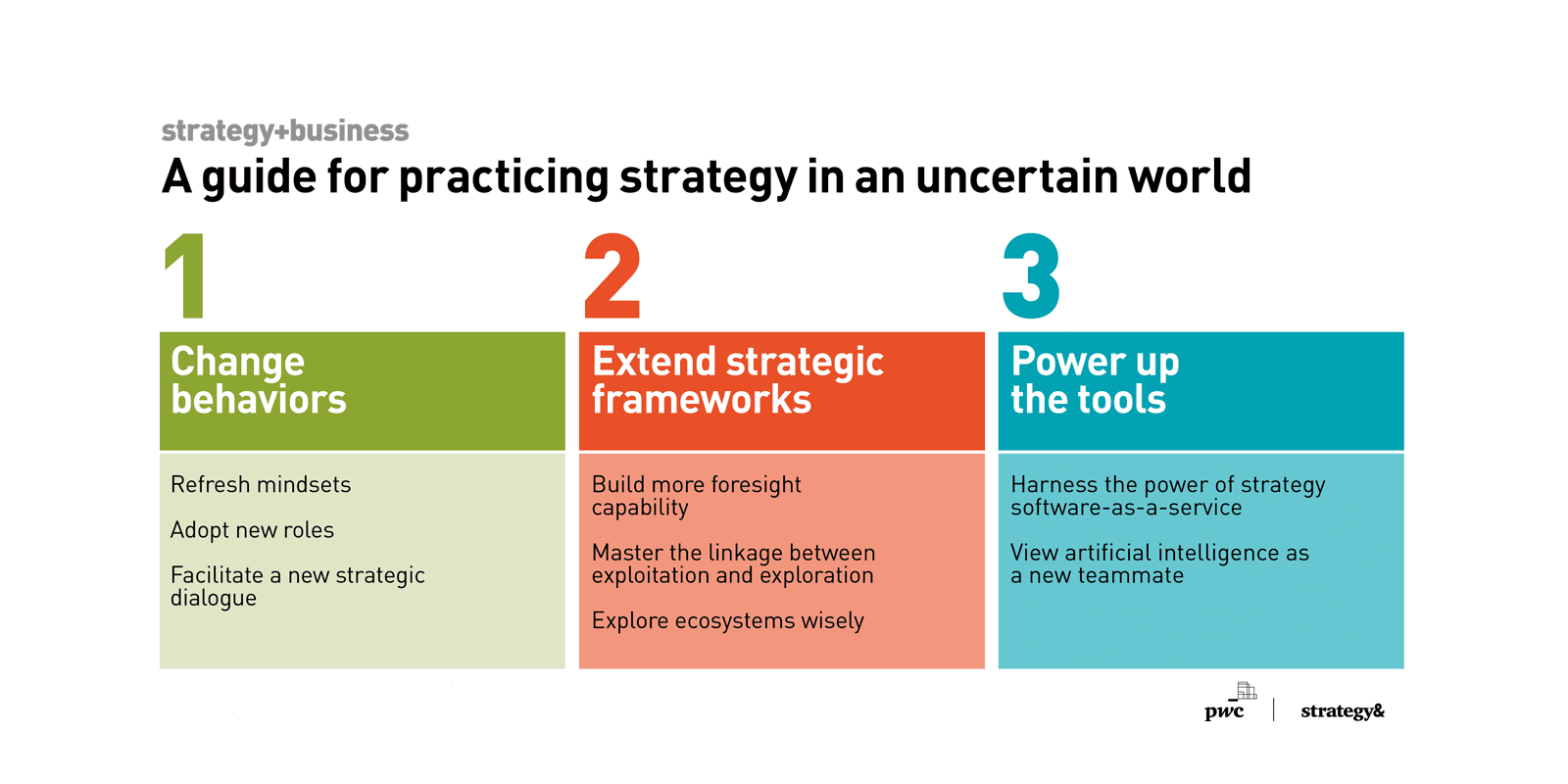Practicing strategy in an uncertain world
A modern strategy that works will require leaders to learn new skills and apply new tools. Here’s a primer for a refreshed approach.
A version of this article appeared in the Summer 2021 issue of strategy+business.
Kristian Ebbesen Fjelde and his team knew that the executive committee meeting scheduled in mid-2019 to discuss the future strategy of their company was more important than most. Equinor’s leadership had changed the company’s name in May 2018 from Statoil to signify its intention to make it a more diversified energy company and take a leading role in the long-term goal of transitioning out of fossil fuels. Equinor was Norway’s biggest energy producer, and its leaders understood that the structural shifts in the market necessitated a radical shift in the business that would require more than a simple rebranding. Instead of putting together a presentation, Fjelde decided to run a “strategic beliefs” card game. His team circulated 16 statements, each describing what might become a core belief of the company. They covered everything from the direction of commodity prices to the impacts of climate change. The executives were asked to reveal one of two cards — depicting a thumbs-up or a thumbs-down — as a reaction to the statements and explain how they reached that view.
There were significant differences of opinion, but after an intense discussion, the leadership team came to a consensus. The inclusive nature of the discussion, the use of a different kind of facilitating tool, and the understanding that the results were not window dressing but rather core corporate beliefs underscored the importance of the exercise: developing a strategy that worked.
In too many cases, strategic discussions are not this fruitful. Often they result in a set of goals, bullet points, or statements that masquerade as strategy, but they don’t set out the clear direction, distinctive positioning, and feasible plan you would expect. It’s no wonder that a 2018 survey conducted by Strategy&, PwC’s strategy consulting business, found that 65 percent of executives think their organization lacks a winning strategy.
That’s a damning statistic. Because it means that even people who lead company transformations aren’t confident that they are on the right path, though they probably were part of the discussion to set the direction. And today, the stakes are getting even higher. Organizations are facing a prolonged period of uncertainty, challenging economic conditions, seismic geopolitical shifts, climate change, and societal fragility.
In this context, “strategy is more important than ever, but in a different way than we’ve traditionally thought of it: the metaphorical leader on a horse with a sword who says, ‘follow me,’” says Rita Gunther McGrath, professor at Columbia Business School. Instead, strategy should be conceived, developed, and executed in a more inclusive, dynamic, creative, and experimental way.
What does this mean in practice? Drawing from interviews with leading management thinkers, academics, and executives, I highlight three aspects of strategy that require more attention and skill: behaviors, frameworks, and tools. Pioneers have already gotten the message; others have an opportunity to catch up. But first, we need to understand what strategy is in the current context.
Modern strategy
The challenge is that the term strategy is often misunderstood. Ask somebody outside the strategy team what it means — let alone what the company’s strategy is — and you’ll often get a quizzical look. Too often, as Bill Fischer of MIT’s Sloan School of Management says, “strategy is the ex post rationalization of coherent tactics.” Playing to Win authors A.G. Lafley and Roger L. Martin describe strategy as “a set of choices about winning” or, more specifically, “an integrated set of choices that uniquely positions the firm in its industry so as to create sustainable advantage and superior value relative to the competition.”
Strategy should bring clarity to the uniqueness, direction, and activities of an organization. It should certainly generate more than short-term profits. Vijay Govindarajan of the Tuck School of Business at Dartmouth College says that “we need to restore purpose as a central tenet for strategy.” This, he argues, should result “in optimized profits and optimized value for various stakeholders.” Note the use of value and stakeholders — today’s successful strategy is not simply based on shareholder return. This raises the bar again for strategy; Julian Birkinshaw of the London Business School says it leads to “more complex trade-offs in a world of responsible capitalism.”
Strategy also applies to different organizational constructs (enterprise, business unit, function) and comes in many forms (traditional, adaptive, visionary, inventive, etc.), according to the degree of organizational change, the process involved, the level of input from employees, the time frame, and the degree of disruption facing the organization. Amy Webb, founder of the U.S.-based Future Today Institute, makes a distinction between “tactical decisions (very near term), strategy (a few years [two to five] out), visioning (longer term), and systems-level disruption and evolution (very long term).” Strategy plays a key role in this continuum in resolving “the tension between that systems-level, macro change and the day-to-day tactical operations of a company.”
With these insights in mind, we can get back to the three aspects of strategy that should be strengthened: behaviors, frameworks, and tools.
Change behaviors
Strategy is a personal endeavor. Its success largely comes down to how it changes the way people think, feel, and act. These three actions can lead to better results.
Refresh mindsets. The mindset of the leader — and strategist — is a critical aspect of the strategy process. Start with a presumption of maximizing human contribution to the organization rather than maximizing compliance to a set of rules, advises Gary Hamel, cofounder of the Management Lab. In practice, this means finding a way to encourage participation, discourse, and challenge; transparency (of status, challenges, metrics) is critical. Move away from the all-too-common approach of presenting yourself as an elite team seeking selective inputs and then broadcasting the strategy. Demonstrate “curiosity, empathy, the willingness to take in new information, the willingness to welcome new information…and be open to surprise,” says Columbia’s McGrath. Humility helps too. “It’s hard to learn if you believe you already know [something], and we’re hardwired to believe we already know,” says Amy Edmondson of Harvard Business School. She uses the example of a clinical director of an intensive care unit who encourages challenge through careful framing, using statements such as “I might miss something, so I need to hear from you.”
The transformation of Microsoft under Satya Nadella’s leadership is another case in point. He led the change from a “know-it-all” culture to a “learn-it-all” culture. The message: Look more widely and wisely at examples outside the industry norms, and challenge conventional wisdom and constraints. Create time for reflection, playful experimentation, and ongoing cycles of testing and adjusting.
Adopt new roles. Leaders should guard against conceit, argues Hamel, given “there’s no small group of leaders at the top of any organization today that has the bandwidth, the imagination, and the foresight to develop a point of view about where the organization should go next.” Instead, says Joost Minnaar, cofounder of Dutch firm Corporate Rebels, which describes itself as a movement to make work fun, act as a “curator of the good ideas from the grass roots…and then as a user of their authority to spread these ideas across the organization.” He was referring to the success of this approach at Buurtzorg, a Dutch home care nursing organization. Buurtzorg generated impressive results (related to patient outcomes, customer and employee satisfaction, and costs) through an approach based on autonomous working, supported by a small central management team.
Without losing your strategic skill set, learn to become an architect at the center of a network of specialists. Show more interest in others, draw in expertise, and convene dialogues. In particular, embrace the highly valuable and often scarce expertise in AI and data analytics, urges Daniel Hulme, CEO of Satalia, a global AI company specializing in enterprise solutions to efficiency problems. In practice, this means having leaders involved earlier in the strategic process and asking more questions; in the case of AI, many CEOs are unsure what AI can actually do, so they are wary about using it as a management tool. Hulme spends a lot of his time explaining AI’s potential.
Being coached in this way doesn’t come naturally for those used to a directive or managerial approach. It takes “a leap of faith at the beginning as you don’t feel like you’re adding much value. But asking questions is very powerful,” says Herminia Ibarra of the London Business School. It can help to focus on “doing” to reinforce the learning through the type of innovation sprints pioneered in the Google Ventures five-day method of experimentation.
Facilitate a new strategic dialogue. Open up the strategic dialogue beyond the executive committee. Engender more creativity, imagination, and buy-in with a new strategy by involving stakeholders of different backgrounds, expertise, and styles from the beginning. This approach also mitigates groupthink and conservatism by reducing bias, which in practice means that “people in power will be less likely to give you the benefit of the doubt if you’re different. And you respond to that by being more cautious,” says Ibarra. And, according to Columbia’s McGrath, “the answers to whatever your puzzle is may come from very unexpected places — it could be a person who normally doesn’t have access to power.”
Make this a routine, not a special exercise. And communicate the strategy — and the need for change specifically — in a way that is positive and personal. Nokia, for example, crowdsourced ideas for its new strategy on a regular basis — splitting teams into different areas (understanding the unarticulated needs of customers, disruptions and trends, industry dogmas, capabilities to be leveraged or built). One CEO of a technology company regularly meets 20 young people, selected at random from the organization, for breakfast to hear their perspectives. Jos de Blok, founder of Buurtzorg, uses his blog to explain a strategic decision and then invites everybody to comment in an open platform.
In these dialogues, frame the challenge carefully, invite participation, listen attentively without interruption, ask open and incisive questions, and respond thoughtfully, especially when you hear a contrarian view. This creates the psychological safety required for people to say what they really think, and to share their best ideas. The result is honest, meaningful conversations that avoid the “theater” we often see.
Edmondson used the example of a newly appointed CFO who had agreed to an acquisition, though he had reservations that he didn’t immediately share with his team. The deal was a flop. “I didn’t want to be the skunk at the picnic,” he said of his reticence in the postmortem. Edmondson calls this description “a classic example of holding the wrong frame. When you’re making a strategic decision, you’re not at a picnic. And when you have a dissenting view, you’re not a skunk. You’re a valued team member.”
Structuring the dialogue is critical too, especially to mitigate cognitive biases. For example, you can use rungs on what is called a ladder of inference skillfully: Work from facts, interpretations, assumptions, conclusions, and beliefs to actions in a way that avoids the classic mistakes of generalizations or lazy judgments. And collate, and use, the best possible data from within and outside your organization to inform the strategy and monitor its impact.
Extend strategic frameworks
There’s a plethora of strategic frameworks today that have evolved over the past 70 years to help businesses make decisions. Some have stood the test of time, but still could be refreshed for today’s world..
Build more foresight capability. If you believe COVID-19 will cause substantial economic aftershocks and prolonged uncertainty, invest in foresight capability, that is, the ability to sense, shape, and adapt to events. This means collating insight from within and outside the organization on current and near-term dynamics (e.g., customer behavior) as well as indicators of systemic (e.g., demographic and macroeconomic) changes. Then filter out the noise and decide what to address — on a spectrum of immediate changes to long-term investments. Few organizations do this in a formal way. They don’t, for example, have cross-functional meetings that help pick up signals from different areas of the business and from their ecosystems.
Strategic foresight isn’t just a matter of making predictions; it’s about creating a state of readiness and knowing when to act. No one can predict the future, but you can ask questions, explore new avenues, and experiment as a way to avoid slipping into the trap of blind reliance on old models. Invest more time in learning from pioneers. For example, in 2006, U.S. food and beverage company PepsiCo began to pursue a strategy anchored in four aspects of sustainability: products, planet, people, and impact . Named Performance with a Purpose (PwP), this strategy meant satisfying multiple stakeholder interests and delivering strong results. And after the implementation of PwP, revenue grew by 80 percent in the following decade, PepsiCo stock outperformed its sector index and the S&P 500 Index, women held nearly 40 percent of management roles, and environmental impacts were reduced significantly.
Though not statistically representative, this approach is far more likely to generate strategic insights than using “common” or “best” practices.
Master the linkage between exploitation and exploration. To create an “ambidextrous” organization, exploit existing capabilities and explore new opportunities, then make the link between the two activities. This is easier said than done. Often execution goes wrong because resources are not deployed to the strategic priorities; some capability is missing in portfolio management. Institutionalized budgets are negotiated every year, which creates unhelpful rigidity when situations change and companies need need to redeploy investments.
Alex Osterwalder, cofounder of Switzerland-based Strategyzer, a business consultancy, says that “too often innovation activities are completely disconnected from [the overall] strategy.” Karolin Frankenberger of the University of St. Gallen says that there is a “focus on what needs to be separated, and how to give the entity autonomy. But the strategy is only likely to be successful if separation is combined with linking mechanisms.” In practice, these mechanisms include making decisions jointly, using shared resources, reassigning talent, and designing appropriate incentive structures.
The demise of conglomerate GE illustrates the consequences of investing too much in exploring the future (digital activities in particular) and not enough in managing the present; GE established a separate business unit, GE Digital, in 2015, spending billions on digital initiatives that didn’t pan out. Ping An, a Chinese financial-services group, was more prescient. It used the foresight it gained while researching new technology to make improvements to its existing businesses and at the same time developed new business models to serve other financial institutions.
Explore ecosystems wisely. Industry boundaries are blurring as ecosystems — networks of companies that collaborate across industries to create new products or services — grow in importance. However, many leadership teams still think of industries as silos. This can limit the scope of their exploration.
Leaders need to recognize that strategy in this world of ecosystems is different from strategy practiced in vertically integrated organizations operating in a single industry. Work through a number of critical questions, such as: Which ecosystems should we participate in, and on what terms? Which role should we play in the ecosystem (e.g., orchestrator, partner, complementor)? How able are we to step up to the demands of ecosystem “life”? The latter requires a belief in shared value creation (away from sole, proprietary activities), more transparency (to build trust between ecosystem partners), a greater degree of dynamism (to adjust for new information, or interactions with ecosystem partners), and an outward-facing culture (given the extent of dependencies). Ecosystem pioneers such as Google, Alibaba, and Amazon demonstrate these characteristics.
Power up the tools
For too long there has been a “knowing–doing” gap, as Howard Yu of the IMD business school puts it, between what has been taught — or read — and what has been practiced. A lack of tools hasn’t helped close that gap.
Harness the power of strategy software-as-a-service. Innovative tools and books, from companies such as Strategy Tools and Strategyzer, illustrate strategic concepts and frameworks using design skills. They also “gamify” the strategy process using techniques found in play environments. For example, they run simulations of strategic scenarios or situations that can make strategy feel more real and enriching for participants than working on a case study or listening to a presentation. Such tools should be used carefully, however. Though fun and engaging, they have to be integrated into the existing strategy process for them to work, says Christian Rangen, cofounder of Strategy Tools.
It’s not a new concept — the practice dates back almost 20 years to the work of Bart Victor in Serious Play — but adoption of these tools has increased as work has moved online and organizations have seen the power of strategy processes that are open and scalable. Such tools also give an opportunity for people to contribute who might have been crowded out by “big characters” in smaller or face-to-face sessions. A greater level of participation enables more coaching and encourages a higher-quality dialogue than the typical top-down strategy exercises. This, in turn, helps upskill the participants and means that collaborators in the strategy process have a shared language, which improves effectiveness. As the data from these exercises is captured, leaders have the opportunity to analyze and identify where causality is linked to decisions.
View AI as a new teammate. AI has the potential to play a more prominent role in the strategy process. Though the concept of an integrated human and AI strategy machine also isn’t brand new, some of the applications it might perform are. AI can interrogate data (from within the company and from a third party) to uncover new relationships or correlations that can enrich the material available to strategic thinkers. At this stage, it’s unlikely to be the source of strategic recommendations, breakthrough ideas, or big-picture thinking. “It’s still very much left to the human being to do the exploration. It requires creativity, pulling lots of different data sources, luck, and so many things that machines don’t have access to,” says Satalia’s Hulme.
Pioneers — corporate organizations, consultancies, and investors — are already using AI in a number of areas of strategy development and execution. For example:
• Generating intelligence on the impact of external events or changes in sentiment on the organization.
• Analyzing patterns of customer behavior. OakNorth, a U.K.-based fintech, uses AI in loan applications and in the analysis of credit data, which then feeds into strategic scenarios.
• Optimizing expenditure and resource allocation, for example, in pharmaceutical R&D, customer churn, and sales and marketing.
• Running simulations and scenarios. A team at Salesforce, a U.S. enterprise software company, has developed a system called AI Economist to identify optimal tax strategies for an economy’s tax code using sophisticated simulations.
• Originating new commercial opportunities, for example, acquisition targets. CB Insights, an AI startup, provides this functionality as a service, and IBMPDF has used it for its own portfolio of investments.
• Making predictions. Netflix, for example, uses AI to help it decide what new programs to make.
The COVID-19 pandemic might just be a catalyst for refreshing the way strategy is practiced. It will require upskilling and a willingness to experiment.
Think of AI as a new teammate. Keith Strier, vice president of worldwide AI initiatives at Nvidia, a U.S. company specializing in visual computing technologies, argues that “it’s not that AI should replace strategists, or that [AI] will come up with things that [strategists] couldn’t think of…but the frontier of strategy involves intelligent humans and smart machines coming together to create new strategies.” AI is not a substitute for careful thought and strategic dialogue. Upskill your understanding and application of AI to take advantage of what is on offer. Not enough people involved in strategy have. It would be difficult “to find more than 10 percent of the Fortune 500 doing anything I would describe as material, meaningful AI,” says Strier.
The COVID-19 pandemic might just be a catalyst for refreshing the way strategy is practiced. It will require upskilling and a willingness to experiment, as demonstrated by Equinor’s Fjelde with his strategic beliefs card game. The next generation of leaders — and strategists — will certainly need to be more inclusive, curious, humble, and dynamic, and must have a greater appreciation of the potential (and limitations) of technology and ecosystems.
Author profile:
- David Lancefield is a strategist and coach who has advised more than 35 CEOs and has led 15 digital transformations. He is a contributing editor of strategy+business, and he also hosts the interview series Lancefield on the Line and publishes the email newsletter Flashes+Sparks. Lancefield was a senior partner with Strategy&, PwC’s strategy consulting business.





